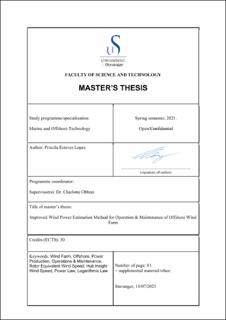| dc.description.abstract | Offshore wind is a rapidly maturing renewable energy technology that is poised to play an important role in future energy systems. In 2018, offshore wind provided a tiny fraction of global electricity supply, but it is set to expand strongly in the coming decades into a USD 1 trillion business (IEA`s ‘Renewable Energy Market 2019’ report). Turbines are growing in size and in terms of the power capacity they can provide, which in turn is delivering major performance and cost improvements for offshore wind farms.
According to IEC 61400-12-1 standard procedure, for a power curve validation of wind turbines, ideally the measurement of the wind speed would take place at hub height. The underlying assumption is that this measured hub height wind speed sufficiently represents the wind speed across the entire swept area of the turbine rotor. Now that wind turbines are getting bigger, it is very questionable whether the hub height wind speed (HHWS) method is appropriate since it could under-estimate the kinetic energy flux through the rotor area. This can result in inconsistent and potentially incorrect power predictions, which feed into various technical and economic analyses, ranging from grid integration (Mahoney et al., 2012), life-cycle cost analyses (Jong et al., 2017), and capacity expansion studies (Hasager et al., 2015).
This study shows a different method, rotor equivalent wind speed (REWS), in which the wind velocities are measured at several heights across the rotor area and make a comparison of the estimate available power from the HHWS versus REWS methods. Wind speeds extrapolation was made to cover a tip height of 208m, for a 10-MW reference wind turbine, since no wind speed data above 100 m was available for the three different sites, FINO 1, FINO 3 and Frøya.
In order to extrapolate wind speeds at elevations above 100 m up to tip height at 208 m, the power law and the standard logarithmic law wind profiles were assessed to identify a suitable model that could represent offshore wind profile. For the power law, a wind shear coefficient (alpha) was obtained by fitting to the measurements of observed heights. For the logarithmic model, terrain roughness of 0.003 was considered. The result indicates that the power law has better performance with regards to extrapolating wind characteristics for all three different locations.
Finally, the difference between HHWS and REWS available power estimates of ~4.9%, ~3%, and ~8.5% for FINO 1, FINO 3, and Frøya, respectively, illustrate the importance of accounting for rotor-layer wind shear when predicting available power. A comparison to actual power outputs will be a subject of future work. All sites, FINO 1, FINO 3 and Frøya, contain a meteorological mast (MetMast) with a total of 14, 9 and 6 years of weather data, respectively. | |
